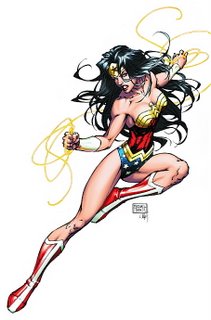Sunday, December 10, 2006
Compare/Contrast: Tintin vs. Turner
Tintin Pantoja has updated her LiveJournal with some thoughts spurred by the blogosphere's reaction to her manga-influenced Womder Woman proposal. It's a great post, but I especially liked this section:
Consider the following two images: Which one conveys a sense of fun?
I love that image on the left: It really communicates a sense that Wonder Woman herself enjoys her powers of flight. If there's any sense of wonderment in the second image, it's astonishment that Turner's female characters can move about at all after having their internal organs removed. (Seriously, what the heck is up with WW's waist in that picture?)
Here's hoping that someday everyone who was excited by Tintin's proposal gets a chance to read the full story, in whatever form it might take. And here's hoping that DC eventually gets around to offering alternative presentations of its great female characters that don't alienate readers who don't like seeing women depicted as sexual objects.
* Please note the "many" qualifier. If manga = fun, then Western comics like Banana Sunday, Bone, Steven Weissman's "Yikes" books, and the Adhouse "Project" anthologies are manga. OK, really I should have just said it's books from the "Big Two" that are lacking in fun for me.
Tintin Pantoja has updated her LiveJournal with some thoughts spurred by the blogosphere's reaction to her manga-influenced Womder Woman proposal. It's a great post, but I especially liked this section:
While the medium called sequential art is fully capable of conveying literary and powerful stories "of great sound and magnitude", we often forget that the etymology of the words 'comics' and 'manga' share connotations of playful, frivolous entertainment. The Wonder Woman manga was conceived in the spirit of the latter.I think that sums up a big reason why my sequential art reading list is almost entirely manga these days: I get a sense of fun from manga that I don't see in many Western comics*, especially those from Marvel and DC. I'm guessing Tintin's playful approach to her Wonder Woman project is part of the reason why it resonated with so many comic fans who have little or no interest in reading the "regular" WW comic.
Consider the following two images: Which one conveys a sense of fun?
 |  |
| Tintin Pantoja's Wonder Woman | Michael Turner's Wonder Woman |
I love that image on the left: It really communicates a sense that Wonder Woman herself enjoys her powers of flight. If there's any sense of wonderment in the second image, it's astonishment that Turner's female characters can move about at all after having their internal organs removed. (Seriously, what the heck is up with WW's waist in that picture?)
Here's hoping that someday everyone who was excited by Tintin's proposal gets a chance to read the full story, in whatever form it might take. And here's hoping that DC eventually gets around to offering alternative presentations of its great female characters that don't alienate readers who don't like seeing women depicted as sexual objects.
* Please note the "many" qualifier. If manga = fun, then Western comics like Banana Sunday, Bone, Steven Weissman's "Yikes" books, and the Adhouse "Project" anthologies are manga. OK, really I should have just said it's books from the "Big Two" that are lacking in fun for me.
Labels: Shōjo WW Watch, Tintin Pantoja